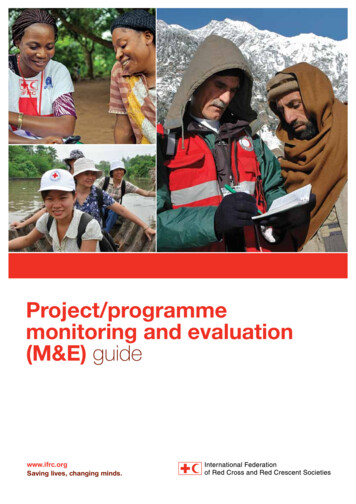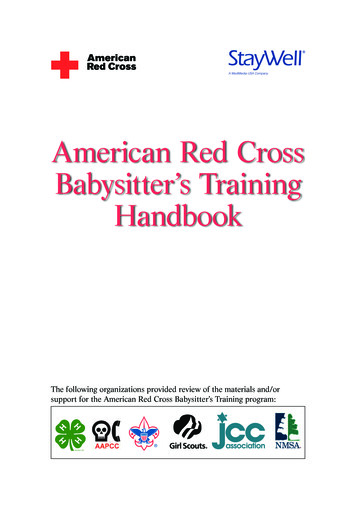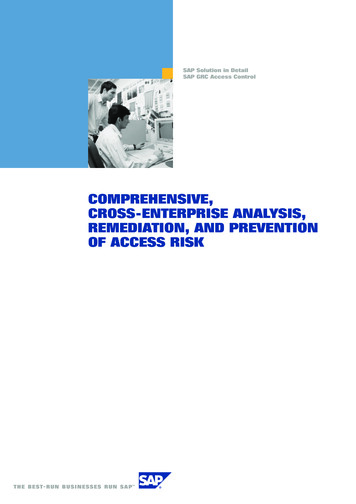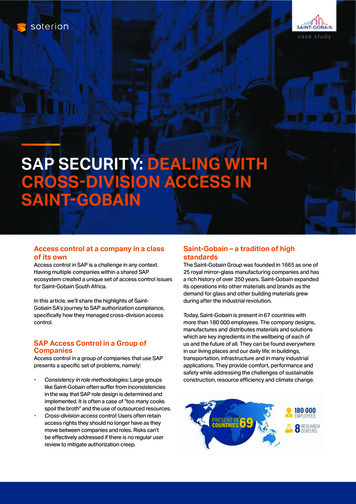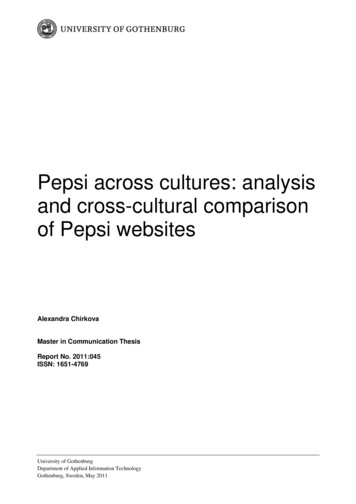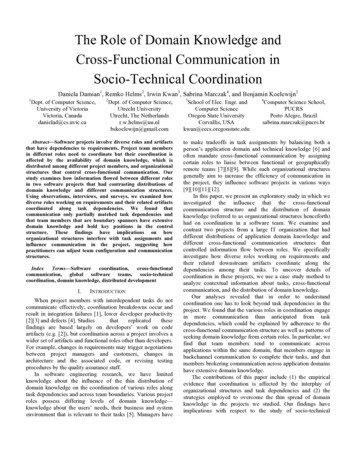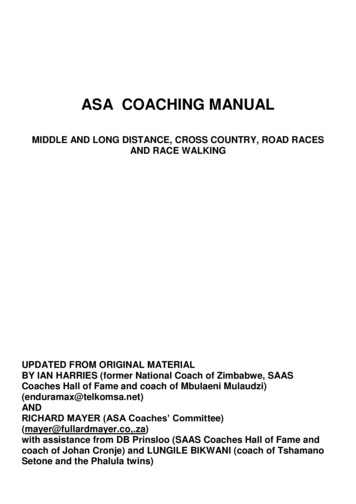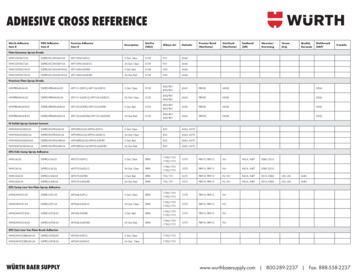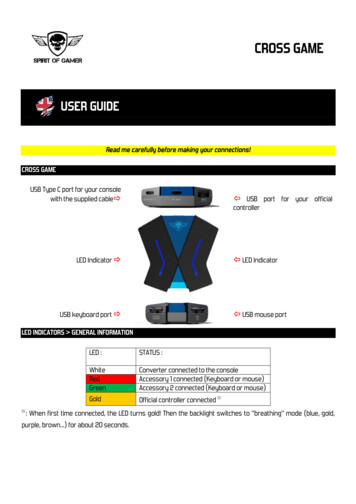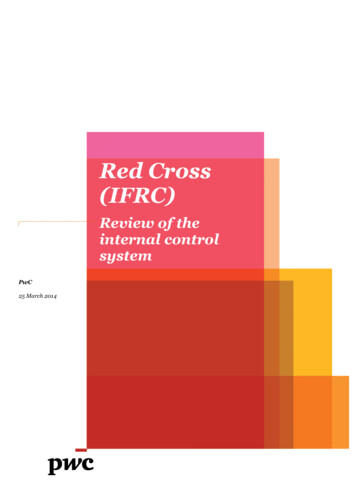
Transcription
Red Cross(IFRC)Review of theinternal controlsystemPwC25 March 2014
Table of contents1Executive summary12Background82.1Assignment82.2Approach and methodology82.3Method3The Red Cross Movement10113.1About the Red Cross Movement113.2About the Federation (IFRC)113.3About the member organizations114Constitution and Rules and Procedures134.2Rules of Procedures144.3Financial regulations145IFRC Financial Management systems155.1General155.2Overview financial systems166General descriptions of procedures and routines186.1Agreements186.2Audit186.3Fraud and corruption206.4Working advance216.5Procurement227Our observations and recommendations237.1IFRC Head-quarter in Geneva237.2IFRC – Zone office Kuala Lumpur (Asia & Pacific Zone)337.3IFRC – Zone office Nairobi (Africa Zone)457.4IFRC – Regional delegation Nairobi517.5Country Office – Khartoum, Sudan587.6National Society – Khartoum, Sudan651 (99)
7.78National Society – Kabul, AfghanistanDesk-study – IFRC delegation in Pakistan74898.1Background898.2Reports898.3Summary of outcome of the reports908.4Summary of recommendations, action plan and follow-up928.5Our assessment and recommendations based on the desk-study96AppendixAppendix 1Terms of ReferenceAppendix 2List of interviewsAppendix 3Organogram3 a – IFRC Head-quarter Geneva3 b – IFRC Asia Pacific Zone Office3 c – IFRC Africa Zone Office3 d – IFRC Regional Delegation Nairobi3 e – IFRC Country Office Khartoum, Sudan3 f – Sudanese Red Crescent Society3 g – IFRC Country Office, Kabul, Afghanistan3 h – Afghan Red Cross and Red Crescent Society2 (99)
1 Executive summarySida has awarded PwC the assignment to undertake a review of the internal controlsystem at the Red Cross (IFRC – International Federation of Red Cross and RedCrescent Societies). Sida undertakes this review as a part of following-up on SwedishRed Cross (SRC) funds, which are channelled through the IFRC, in order to ensurethat these funds are handled in accordance with the requirements in the agreementsand that the funds are used for the intended purposes. The main part of theassignment has been carried out at offices at all levels of the IFRC (Geneva, Nairobi,Khartoum, Kuala Lumpur and Kabul), as well as at the National Societies inKhartoum and Kabul.The aim of the review is to verify whether IFRC has reliable and relevant routines,resources and competence in order to be able to implement Sida’s contributions. Thereview will assess whether the management and financial systems are in order, andshall provide recommendations for improvement. The assignment also includes adesk-study of the IFRC delegation in Pakistan following- up on a reporting ofallegations of fraud and irregularities and of the actions taken.Below, we have summarized our assessments and observations on an overall level,based on the areas of focus in the Terms of Reference. For further descriptions andrecommendations, we refer to the full report.OrganizationThe International Red Cross and Red Crescent Movement is the world's largesthumanitarian network. The Movement is made up of nearly 100 million members,volunteers and supporters in 189 National Societies. It has three main componentscomprising of The International Committee of the Red Cross (ICRC), TheInternational Federation of Red Cross and Red Crescent Societies (IFRC) and 189members Red Cross and Red Crescent Societies. The main office of the IFRC islocated in Geneva. The IFRC Secretariat comprises of the head office and the fielddelegations around the world. There are five Zone offices located in Europe(Budapest), Africa (Nairobi), Americas (Panama), Asia Pacific (Kuala Lumpur), andMiddle East-North Africa (Beirut). There are fourteen (14) permanent regional officesaround the world, and more than 60 country delegations including representativeoffices in New York (to the United Nations), Addis Ababa (to the African Union) andBrussels (to the European Union). It is obvious that the organizational structure ofthe Movement and the Federation is extensive and requires a distinct and transparentorganizational set-up. A decentralization of the regional and country desks to theZones was implemented in 2007.During our review based on the Terms of Reference and the areas of internal control,we noted that the issue of transparency needs to be improved and clarified in regardsto reporting lines, agreements and disclosure policies. The Federation is a large andcomplex organization with many layers of decision-making from Head-office, Zoneoffice, Regional office and Country office. We note that Country offices are establishedwhere the National Society needs capacity support for a limited time in order tostrengthen the National Society, however we see that many Country offices have beenestablished for a long time (e.g. Country office in Khartoum).1 (99)
We also note that the organizational set-up in the Federation in regards to reportingis that all departments at the head-quarters and the Directors of Zones are reportingdirectly to the Secretary General. Our assessment is that this constitutes a risk andmight hinder transparency and accountability. See further paragraph 7.1 underobservations and recommendations in the report.During the last two years, there has been a greater focus on risk management andanti-corruption work. An “Accountability Framework” was presented at the GeneralAssembly in Sidney in November 2013, and there are indications of further work to becarried out with a “Disclosure Policy”, in terms of transparency and accountability.However, we note that the anti-corruption policy was launched in 2011 and there arestill several areas for improvement in regards to implementing the policy within theorganization in terms of anti-corruption work, establishing and ensuring compliancewith routines and procedures, as well as clarifying dissemination of information todonors and stakeholders. See further paragraph 7.1.2 under observations andrecommendations in the report.Internal control systemThe internal control system at the IFRC is well established. The Federation hasproduced a large number of procedures and routine documentation for theorganization. All regulations and procedures documents must be complied with bythe Federation offices. However, we noted during our review that several documentshas not been revised or updated for a number of years, which we recommend is beingdone on a continuous basis.IFRC regulations and procedures documentation are not an imperative for NationalSocieties as being recipients of funding, hence they are able to set up their ownsystems for procedures and routines. However, according to the CooperationAgreement, the National Societies are obliged to implement systems and routines toensure efficient use of funds and implementation of activities. We note that there isno specific follow-up by IFRC on compliance with rules and regulations at NationalSocieties level, which is mainly undertaken by local audits. We also note that thefollow-up on recommendations made in local audit reports is not carried out in asystematic manner.In the “Strategy 2020”, one of the activities to enable the overall objectives is to buildstrong National Red Cross and Red Crescent Societies. In order to facilitate theseactivities, a specific self-assessment tool has been produced called OCAC(Organizational Capacity Assessment and Certification). This assessment tool wasdistributed within the organization during 2011 and is now in the process of beingimplemented. Before the OCAC tool was introduced, there were other assessmenttools and formats being implemented, however these tools have since then beendeveloped and made coherent within the movement. In regards to building capacityand support in the National Societies, it has been highlighted that there is lack ofresources to carry out activities for capacity support, for which it is also difficult forthe Federation to obtain support.Financial management systemsOur overall assessment of the systems within the IFRC is that the systems are wellestablished, integrated and facilitate reporting and access in several dimensions. It isnoted that the IT-systems are regularly reviewed by the external auditors in order toassess appropriate systems. However, in regards to the logistics and procurementsystem (HLS), we note that this is only implemented and used at headquarters and2 (99)
Zone offices. The system is not implemented at the Regional and Country offices,which indicates a weakness and risk in connection with procurements and logisticsadministrated and handled beyond the Zone office level. We have been informed thata new upgraded logistics system will be implemented, which will also include theRegional and Country offices.Accounting and handling of fundsThe accounting software used within IFRC is called CODA. CODA is a web-enabledtransactional system that stores all financial information. IFRC Finance Departmenthas established rules for account codes verification which are applied with the inputof the documents in order to provide a certain level of control and to prevent incorrectusage of accounts. Until 2010, IFRC had multiple reporting systems in place whichmade it possible for National Societies to access information in CODA. In 2010, IFRCclosed the DMR (Donor Monitoring Reporting) as it was producing misleadingproject reports because of the changes in accounting practices related to IFRS, whichallowed IFRC to concentrate report development on a single platform and close directaccess to the general ledger for non-IFRC parties. Our assessment is that the CODAsystem is well implemented and fully integrated with other supporting systems andplatforms. All offices within the Federation have access to the accounting system andthe accounting system serves as input to the output reporting generator BusinessObjects and the reports are tailored to ensure transparency and accountability.In regards to disbursement routines, we have several observations as regards bothIFRC offices and National Societies. We note that, for instance, in some cases certainindividuals authorize their own costs and advances. In regards to payment within themultilateral cooperation which takes place via the Federation these are executedeither via the Working Advance (WA) or Cash Transfer System. WA is used whenIFRC does not consider the capacity of the NS to be sufficiently strong. Thesepayments can refer to both long-term support and emergency funds. We note thatregulations for Working Advance National Society (WANS) are not complied with infull due to unsettled WANS. Working Advances to delegates and local staff arereported, to a large degree, in the same month in which they are paid out. However,there is an exception when new advances are added and not reported according to thetime schedule stipulated in the regulations. Finance sends quarterly statements topersonnel who have outstanding balances. See further paragraph 6.4 in the report fora description of working advance versus cash transfers.For National Society in Khartoum, Sudan, we note that the financial system,bookkeeping and follow up show weaknesses and it is difficult to assess thecompleteness of the bookkeeping. Due to this weakness, NS is under the WorkingAdvance system. However, we note that a new accounting software was upgradedrecently, which would facilitate improved accounting procedures and follow-up. Thesystem is being implemented together with new routines and the training ofpersonnel. HQ and all of the branches will be able, when the system is fullyimplemented, to use the same system. NS will, then, be able to produce consolidatedaccounts, which is not possible today. At the time of our visit, the bookkeeping in theaccounting system was not up to date, rather, the registration continued in Excel andwas reported in the accounting system after registration.In regards to the National Society in Kabul, Afghanistan, we note that theorganization has a well-established organizational structure for the management andoperation of the daily affairs of the organization and implemented policies andprocedures. However, we also note areas as regards to internal control where there isroom for improvement. It is noted that the bank accounts are single signatories only3 (99)
and, in addition, the new accounting system needs to be further implemented anddocumentation and information management needs improvements in order tostrengthen the internal control.Reporting and follow-upMonitoring and reporting is supported by a number of web-based systems, such as forthe finance systems: CODA (accounting), Apple (software developed by IFRC), SAP(Human Resources), HLS (Logistics) and Business Objects (Reporting). Throughthese systems, the IFRC undertakes a global overview of income, expenditure, as wellas legal commitments (staff contracts, procurement in progress, etc.) at all levels ofthe organization. In 2012, a new budget system, FedBudget, was finalized andintroduced at all levels of the organization. FedBudget is linked directly with CODAand does not require any further input of data.Several reports are produced for monitoring and follow-up. Monthly financial andnarrative reports are submitted by Country delegations and Regional offices to theZone office. Quarterly financial reports are compiled at the Zone office and submittedto Director of Zone and IFRC Geneva. The Budget and Analysis Unit of the GenevaFinance Department reports on the IFRC Secretariat overall financial performanceevery month, and provides advice about corrective measures as required. TheFederation publishes, on a monthly basis, data including global key performanceindicators for Finance and Reporting. This is published on the Senior ManagementDash Board on the International Federations intranet, FedNet, for increasedtransparency and awareness.Reporting to donors is produced on request if required, or donors receive the reportsthrough access to FedNet and on the public website.We have made observations in regards the reporting between National Society andCountry Offices. In our sample testing we note a lack of compliance with agreementsbetween Country Office and National Society regarding the required reporting beforethe next disbursement in regards to working advance. See further chapter 7 underobservations and recommendations in the report.In regards to evaluation and monitoring, the Planning and Evaluation Departmenthave the responsibility of setting up structures and the framework for evaluation ofactivities within the Federation. The framework is to be applied to all evaluationactivities by, or for, the IFRC Secretariat. Evaluations can be commissioned by aperson or department in accordance with the evaluation standards and practicespresented in this framework. This typically involves the programme seniormanagement, or for evaluations involving multiple programme areas, there may be arequirement of the involvement of the Secretariat senior management. All executedevaluation reports are available on the IFRC external webpage.Audit and risk managementRegulations and procedures in regards to the audit within the IFRC are handled bythe Risk Management & Audit Department (RM&A).There is also an Audit and RiskCommittee established as a sub-committee of the Finance Commission. However, theAudit and Risk Committee is not directly established under the Constitution.The Audit & Risk Committee reports to the Finance Commission on the activities,findings and the recommendations of the Audit and Risk Committee, FinanceCommission include a report on the activities of the Audit and Risk Committee to theGoverning Board and General Assembly. Furthermore, the chair of the Audit and Risk4 (99)
Committee provides verbal reporting to the Governing Board at each ordinarymeeting and has a standing invitation to attend all Governing Board Meetings. Inaddition the Chair of the Audit & Risk Committee meets with the President to reporton activities of the ARC.The IFRC Internal Audit Process is regulated in the IFRC Internal Audit Charter(2009), which prescribes the mandate, authority, duties and reporting of the RiskManagement and Audit Department (RM&A). With a right of access to the FederationFinance Commission and the Audit and Risk Committee, RM&A reports directly tothe Secretary General as an independent function of the International FederationSecretariat. We note that the Internal Audit Charter presents a specific reportingstructure which limits the transparency within the organization. Consequently, thereare unclear reporting lines as regards to RM&A, as well as regards the GeneralSecretary. It is important that the Internal audit (RM&A) works independently fromthe General Secretary in order to fulfil its obligations and independence.We also note that the IFRC needs to further develop its organization in regards toimplementing the anti-corruption policy and needs to develop tools and reporting inrelation to identified suspicions and investigations. It is unclear whether sufficientfunds has been budgeted for the activities carried out in relation to anti-corruptionwork, which may limit the implementation and the additional work that needs to befollowed-up and reported upon.Procurement and logisticsRoutines and regulations as regards Procurement are stipulated in the ProcurementManual. The Federation also refers to its external web-site, Procurement Portal.Procurement is understood to cover all actions related to the acquisition of goods,services, and capital items (including renting of equipment or facilities), from needsidentification to supplier contract management. The International Federation isunderstood to include all secretariat offices (Geneva and field offices), regardless oflocation.We note some areas which need to be followed-up and further developed. We notethat there is a weakness in ensuring that procedures in regards to procurement andlogistics are adhered to. We also note that the organization is not completely adheringto the structure that should be in place, for instance that the Zone offices are handlingthe procurement. We note that the regional office in Nairobi is handling procurementand logistics, however this circumstance has also been identified by the head-quartersand will be attended to.We note, in regards to countries were no Legal Status agreement has been signed, thatthe Secretariat lacks the explicit permission to carry out legal acts in the Country andthe legal enforceability of the IFRC acts and the applicable rules continue to comprisea risk. A Legal Status agreement is the explicit expression by a Government of theirrecognition of IFRC “international legal personality” and its corresponding ability tocarry out legal acts in that Country and the terms and conditions under which IFRCcan carry out such legal acts (for example, tax exemption, custom duty exemption,immunity from national legal processes – and inviolability of staff and property). Incountries where procurements are handled by the National Society, this implies arisk in terms of non-compliance with rules and regulations according to IFRC, and ifno Legal Status agreement has been signed, there is also a risk of not being able tocarry out legal acts, or securing the legal ownership of goods.5 (99)
We also note in regards to the logistics and procurement system (HLS), that this isonly implemented and used at headquarters and Zone offices. The system is notimplemented at the Regional and Country offices, which constitutes a weakness inregards to internal control and compliance with rules and regulations.Anti-corruption and irregularitiesThe Fraud and Corruption Prevention and Control Policy was implemented in 2012.Before this policy was implemented the Code of Conduct was previously the maindocument referring to fraud and other related subjects.The anti-corruption and prevention policy applies to the Federation, however, it isstressed that also members (National Societies) within the Federation should
The accounting software used within IFRC is called CODA. CODA is a web-enabled transactional system that stores all financial information. IFRC Finance Department has established rules for ac
